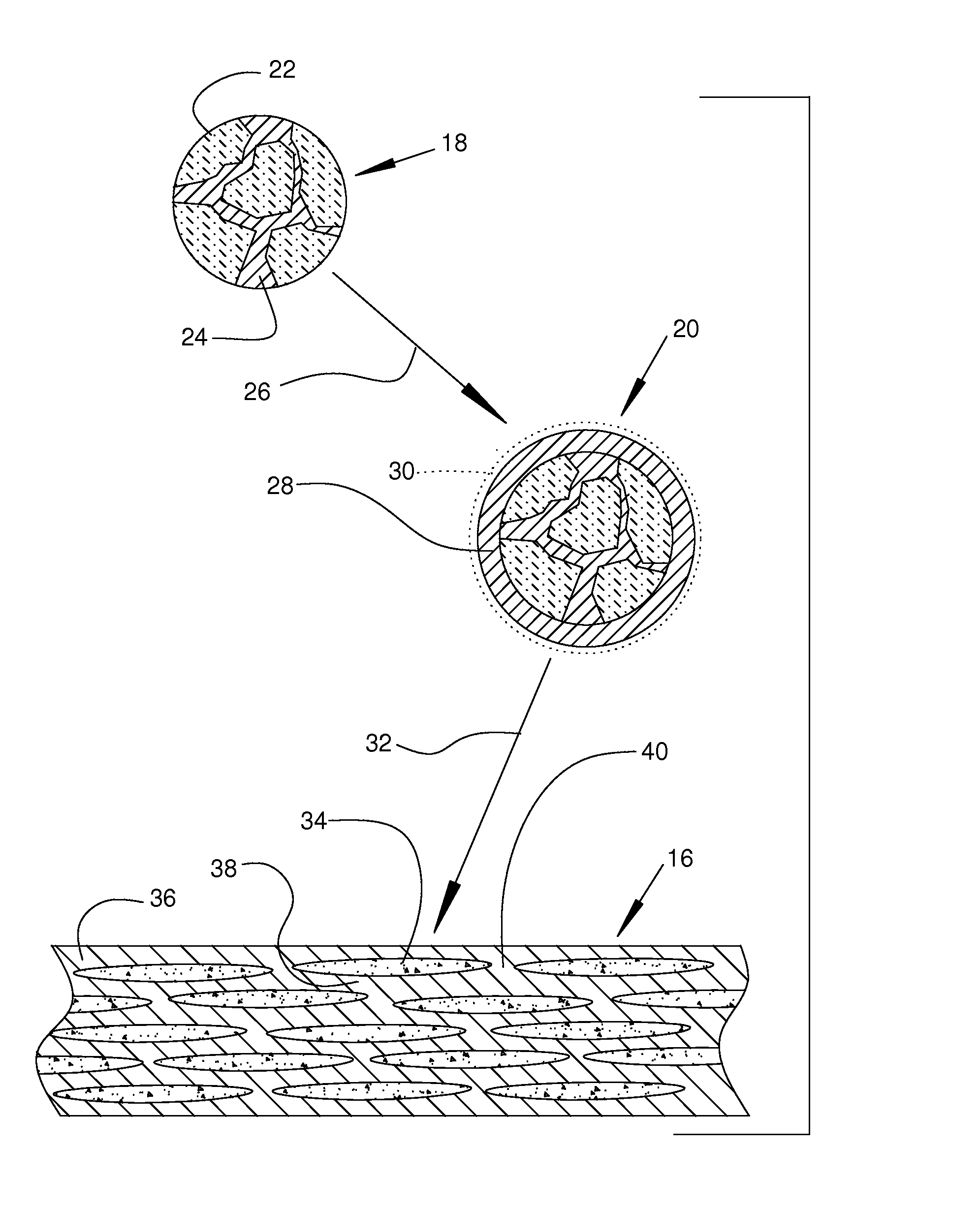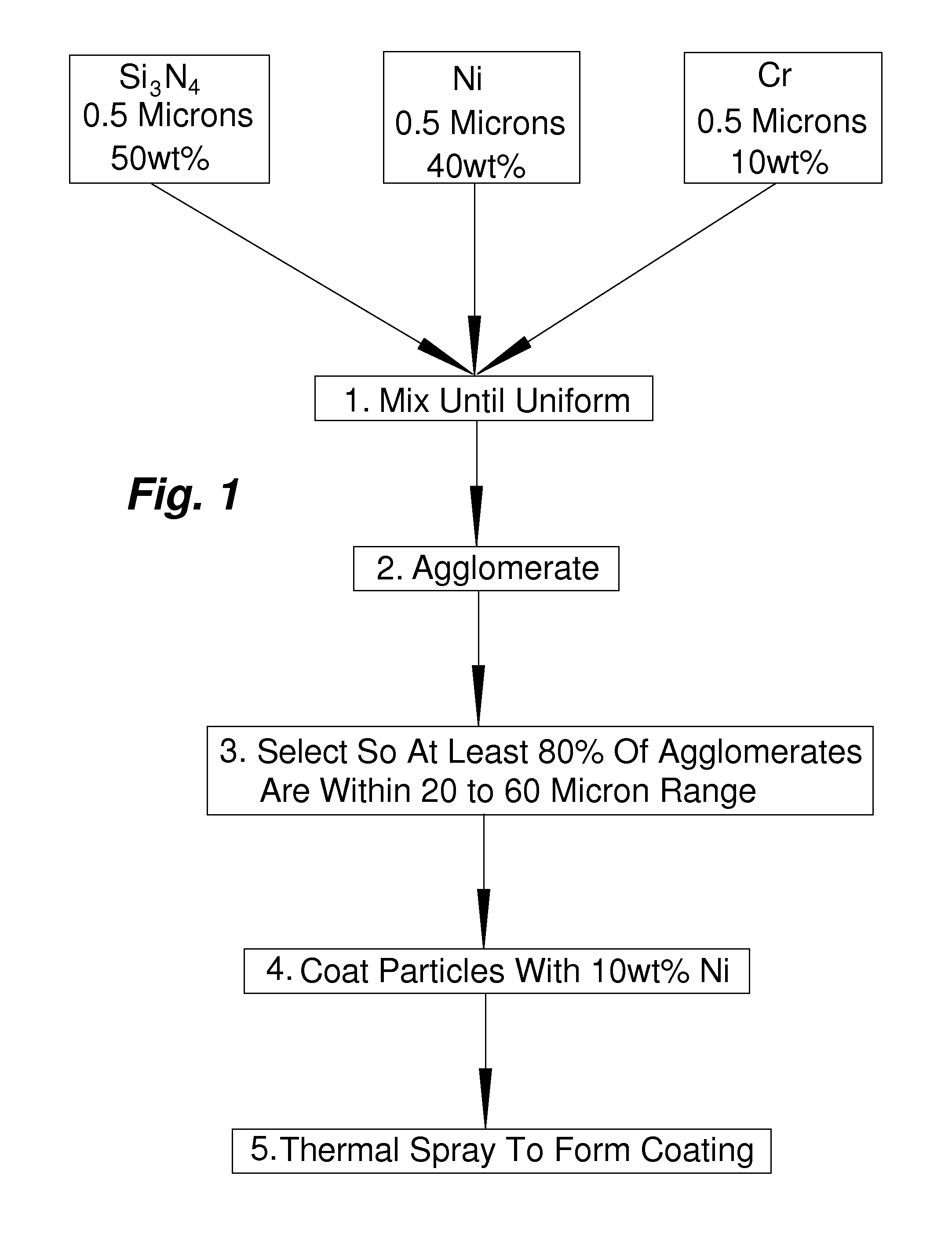Coatings, composition, and method related to non-spalling low density hardface coatings
a low density, hard coating technology, applied in the direction of natural mineral layered products, water-setting substance layered products, transportation and packaging, etc., can solve the problems of thermally sprayed tungsten carbide-cobalt coatings, for example, being very hard, brittle and dense, and ceramics generally decompose instead of melting
- Summary
- Abstract
- Description
- Claims
- Application Information
AI Technical Summary
Benefits of technology
Problems solved by technology
Method used
Image
Examples
example 1
[0039]An agglomerated microcomposite powder was prepared by ball milling 0.5 micron Si3N4 powders with 40 weight percent (wt %) Ni and 10 wt % Cr powder for 24 hours in a ball mill. This Example is diagrammatically illustrated in FIG. 1. A polyvinyl alcohol binder was added along with water and conventional surfactants to reduce the viscosity of the resulting slurry to between 200 and 300 centipoises. An agglomerated powder was formed by spray drying the slurry. The slurry was spray dried at 15,000 revolutions per minute using a centrifugal atomizer, a gas temperature of 300 degrees centigrade, and an exit temperature of 180 degrees Fahrenheit to create approximately spherical, free flowing agglomerated powders. These powders were debound at 200 to 300 degrees centigrade in hydrogen, and sintered for 2 hours at 1250 degrees centigrade to produce a densified, free flowing powder wherein approximately half of the particles had a diameter of approximately 38 microns. The powders were s...
example 2
[0040]Titanium nitride powder having an average particle size of about 1 to 3 microns (manufactured by Kennametal inc) was mechanically alloyed with 32 wt % Ni and 8 wt % Cr powder (average particle size of about 1 to 5 microns) in a Segvari type attrition mill for 24 hours. The attrition mill was manufactured by Union Process. All powders were −325 mesh. The mechanically allowed powders were removed from the mill, dried, and then blended using a high shear mixer with a water-2 percent polyvinyl alcohol solution basified with NH3OH to produce about a 45 volume percent (V %) solids loaded slurry with a viscosity between 100 and 300 centipoises. The slurry was sprayed through a FU11 centrifugal atomizer (manufactured by NIRO) at 18,000 revolutions per minute to produce about 34 micron average particle size agglomerated powders. The spray dried agglomerated powders were debound at approximately 200 to 300 degrees centigrade in hydrogen. The debound agglomerated particles substantially ...
example 3
[0041]A 0.3-0.8 micron alpha SiAlON powder (about 1.2 way in between Al2O3 and Si3N4) was prepared and blended with 40V % Ni—Cr binder. This blend was spray dried and sintered to form about a 35 micron diameter agglomerated core particle. This particle was then clad with 5 to 7V % of a Ni—Ni3P nanocomposite by conventional electroless plating. These powders were then sprayed using an high velocity oxy fuel (HVOF) thermal spray system, to produce a substantially fully dense coating, that exhibited a hardness of 800 to 950 VHN, and bend ductility between 3 and 5 percent as measured using an ASM bend ductility coupon. A 1 / 32nd inch thick steel plate 6 inches long was thermally sprayed to form a 50 to 70 micron thick coating (2 TO 3 mils). This coupon was bent around a tapered mandrel with a diameter varying from 0.5 to 1 inch in diameter. The bend ductility is estimated from where cracks or striations are first observed. A 1 inch bend is approximately 3.5 percent ductility, and a 0.5 i...
PUM
| Property | Measurement | Unit |
|---|---|---|
| particle size | aaaaa | aaaaa |
| particle size | aaaaa | aaaaa |
| temperatures | aaaaa | aaaaa |
Abstract
Description
Claims
Application Information
 Login to View More
Login to View More - R&D
- Intellectual Property
- Life Sciences
- Materials
- Tech Scout
- Unparalleled Data Quality
- Higher Quality Content
- 60% Fewer Hallucinations
Browse by: Latest US Patents, China's latest patents, Technical Efficacy Thesaurus, Application Domain, Technology Topic, Popular Technical Reports.
© 2025 PatSnap. All rights reserved.Legal|Privacy policy|Modern Slavery Act Transparency Statement|Sitemap|About US| Contact US: help@patsnap.com



